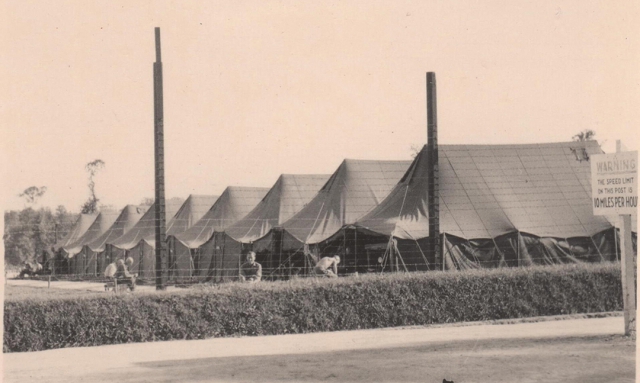
French historians reconstruct the time-faded story of Foucarville.
A remarkable monument to the Allied invasion of Normandy and the march to victory in the European campaign of World War II can be found alongside a narrow road tracing the perimeter of a grain field a few miles inland from Utah Beach, near the tiny village of Foucarville.
For 21 months following D-Day, well beyond the war’s end, more than 100,000 Nazi POWs spent at least some time detained here, under U.S. Army supervision, in a compassionate compound that stood in stark contrast to the horrific death camps of Holocaust Germany.
Continental Prisoner of War Enclosure No. 19 at Foucarville was a 306-acre, kit-built complex that included hydroelectric power, self-contained diesel generators, two hospitals, seven kilometers of railroad track and six locomotives to transport food and goods, including 18 tons of bread baked there daily. It had 50 kitchens, five mess halls, 10 workshops, four churches, a soccer field and two theaters. The camp was connected with 19 miles of high-voltage lines before many of the French villages had electricity at all after the invasion.
The prisoners, mainly German officers and teenagers, lived “under the symbol of liberty,” says Anne Broilliard, a local historian and co-author with Benoit Lenoel of the 2017 book “Prisonniers Allemands en Normandie,” available only in French, which revives the fading history of the U.S.-run enclosure, whose school sign read: “C.C.P.W.E. No. 19 University – Dedicated to the Re-Education of German Youth.” Foucarville was one of four such camps, and the largest, in France during World War II.
U.S. Army chaplains and German pastors taught classes in such subjects as mathematics, literature and
electronics inside the fence. U.S. military vehicles were repaired by detainees in two motor pools there. Toys and furniture were built in the workshops and distributed among area residents at Christmastime. Prisoners grew gardens to feed themselves. U.S. interrogators, including the so-called Ritchie Boys of Camp Ritchie, Md. – multilingual intelligence officers, quite often Jews who escaped Nazi Germany – probed the POWs for strategic information. Few attempted escape.
“I have collected testimonials from 20 different former prisoners,” Lenoel says. “They say they were treated better than anyone at any other camp. That is why the youngest and the generals were there.” The youngest POW, according to the authors, was 12. The camp also held 48 captured generals and one admiral.
After the liberation, the U.S. Army sent the prisoners back to Germany or assigned them to French enclosures to help rebuild the war-torn country, in an agreement struck between U.S. Supreme Allied Commander Gen. Dwight Eisenhower and French Gen. Charles de Gaulle. By 1947, some inmates became “free civil workers” so they could be housed and paid by French employers. France agreed to liberate all the German prisoners on Dec. 31, 1948, and to make citizenship available to workers who qualified.
“Some of the prisoners stayed,” Broilliard says. “Some married French girls. Some were from East Germany, so of course they preferred to stay. It was the beginning of new relations between Germany and France.”
Former prisoners and U.S. veterans who served at the Foucarville camp occasionally return to Normandy to remember their unique place in history. Broilliard and Lenoel continue collecting research on the camp and Col. Warren J. Kennedy of Hartford, Conn.
“The commander was a humanitarian,” Broilliard says. The authors have been communicating with Kennedy’s family members to learn what they can about a little-remembered piece of the Normandy story, now physically gone but not forgotten – a testament to the essential differences in prisoner treatment between the Allies and the Axis during World War II.
The camp’s story has been the subject of exhibits at the Utah Beach Landing Museum in Normandy and at the Airborne Museum in Ste. Mère-Église, the first town liberated by the Allies after the invasion. The book is available on Amazon.
Jeff Stoffer is editor of The American Legion Magazine.
- Magazine

